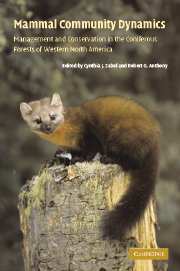 Mammal Community Dynamics
Mammal Community Dynamics Published online by Cambridge University Press: 15 December 2009
Introduction
Human activities have caused fundamental changes in relationships between predators and large herbivores in ecosystems of western North America. In particular, large predators, especially wolves (Canis lupus) and grizzly bears (Ursus arctos), have been eliminated from most of the region. Human developments, as well as agricultural and livestock grazing activities have altered or eliminated many migration routes and habitats of ungulates. Developments such as towns and paved areas have eliminated habitat. Alternatively, human modifications to the landscape, in some cases, have created new and more fertile habitats for ungulates. Habituated ungulates use lawns, golf courses, and agriculture fields that are rich in nutrients in many of the Rocky Mountain states and provinces (Thompson and Henderson 1998).
No magic formula exists for setting goals for the appropriate number of ungulates in a national park or in a more managed ecosystem. National Park Service policy calls for managing for natural processes within the parks, where high ungulate populations may be managed if the concentrations are due to human effects (National Park Service 2001; NPS-77). Unfortunately, most current-day park ecosystems are extensively altered by many human factors, such as the extirpation of large predators, abbreviated or lost migrations of ungulates, and concentrations of ungulates on artificially rich human habitats, such as restored agriculture sites (in many eastern and mid-western parks) or lawns and golf courses within or adjacent to the parks. Determining what constituted natural conditions and natural processes under these altered states can be difficult.
To save this book to your Kindle, first ensure [email protected] is added to your Approved Personal Document E-mail List under your Personal Document Settings on the Manage Your Content and Devices page of your Amazon account. Then enter the ‘name’ part of your Kindle email address below. Find out more about saving to your Kindle.
Note you can select to save to either the @free.kindle.com or @kindle.com variations. ‘@free.kindle.com’ emails are free but can only be saved to your device when it is connected to wi-fi. ‘@kindle.com’ emails can be delivered even when you are not connected to wi-fi, but note that service fees apply.
Find out more about the Kindle Personal Document Service.
To save content items to your account, please confirm that you agree to abide by our usage policies. If this is the first time you use this feature, you will be asked to authorise Cambridge Core to connect with your account. Find out more about saving content to Dropbox.
To save content items to your account, please confirm that you agree to abide by our usage policies. If this is the first time you use this feature, you will be asked to authorise Cambridge Core to connect with your account. Find out more about saving content to Google Drive.